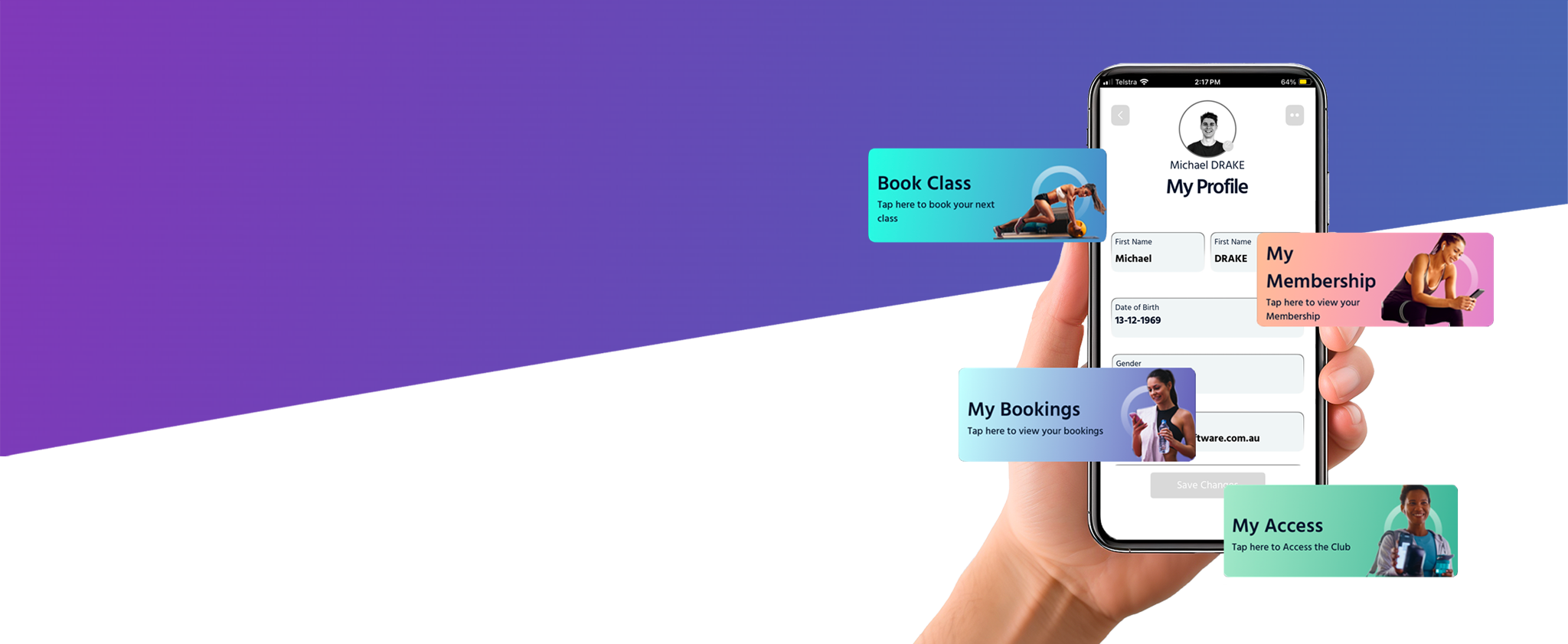
The fitness industry has never been more dynamic — and 2025 is shaping up to be a year of major transformation. From smarter tech to shifting member expectations, gym owners are rethinking how they run their facilities, deliver services, and stay competitive.
The post-pandemic fitness boom introduced hybrid workouts and virtual memberships, but now we’re entering a new phase: one where convenience, personalisation, and automation are the standard, not the exception. Whether you run a boutique studio, a multi-site gym, or a mobile training business, staying ahead of the trends can help you attract new members and keep your existing ones engaged.
Let’s look at the key trends shaping the fitness landscape in 2025 — and how your gym can adapt.
Key Takeaways
- Gym software now automates bookings, billing, and access.
- Hybrid (online + in-person) workouts are here to stay.
- AI and data are driving personalised fitness experiences.
- Wellness and recovery services are in high demand.
- Niche and boutique studios continue to grow.
- Eco-friendly, paperless gyms are gaining traction.
- Retention strategies are more important than ever.
-
Smarter Gym Management Technology
In 2025, gym software is no longer just “nice to have” — it’s essential. Gym owners are leaning on tech to streamline daily operations, reduce admin time, and offer members a seamless experience from sign-up to check-in.
Modern gym management systems now combine class bookings, automated billing, attendance tracking, access control, and reporting all in one place. With members expecting more self-service options, tools like branded mobile apps, automated notifications, and real-time scheduling are becoming the norm.
What’s new is how much data these platforms can now provide. Gym operators can see at a glance which classes are underperforming, which members haven’t visited in weeks, or which payment methods are failing most often — and act on it instantly.
Solutions like Clubfit Software are leading the way here, giving gyms the ability to manage everything from the front desk to member retention in one intuitive dashboard. For small and mid-size gyms especially, smart software is becoming the backbone of sustainable growth.
2. Hybrid Fitness Experiences Are the New Standard
The rise of hybrid fitness is no longer just a response to lockdowns — it’s now a long-term shift in how people train. Members expect the flexibility to join a class at your facility one day, then stream a workout from home the next.
Gyms are offering on-demand video libraries, live-streamed classes, and remote PT sessions alongside in-person programs. Some even sell digital-only memberships to reach a wider audience beyond their physical location.
Whether you run a large gym or a boutique studio, offering hybrid options can help you retain members who travel, work remotely, or just prefer variety. The key is integration — making it easy for members to switch between in-gym and digital without friction.
3. Personalisation Through AI and Data
In 2025, one-size-fits-all programming is being replaced by smart, personalised fitness experiences. With the help of AI and machine learning, gyms can now offer more tailored recommendations based on each member’s goals, attendance, and performance.
Some systems generate individualised workout plans. Others flag at-risk members who haven’t shown up in a while, so staff can follow up before a cancellation happens. Smart machines can even adapt resistance levels or speed based on a member’s past activity.
By using member data more intelligently, gyms can improve retention, increase engagement, and deliver better results — without needing more staff on the floor.
4. Recovery, Wellness, and Mental Health Are Front and Centre
The definition of fitness is expanding. More members are looking for holistic wellness — not just intense training. As a result, gyms are adding services like guided meditation, infrared saunas, massage therapy, and dedicated recovery zones with foam rollers and stretch tools.
There’s also rising demand for quieter spaces, mental health workshops, and classes that focus on stress relief, like yoga or breathwork. These services don’t just support physical recovery — they also help members feel better overall, making them more likely to stay loyal to your gym.
This trend opens up new revenue streams while differentiating your gym from competitors who only focus on workouts.
5. Niche and Boutique Studios Continue to Grow
While large gyms offer variety, boutique studios attract members looking for community, specialisation, and atmosphere. In 2025, the trend toward niche experiences is still gaining momentum — think boxing gyms, cycling-only studios, reformer Pilates spaces, and small-group strength training clubs.
These studios often cater to very specific goals or training styles, and members are willing to pay a premium for that focused experience. Smaller class sizes, themed workouts, and strong trainer-client relationships drive loyalty and referrals.
Even if you run a larger gym, offering boutique-style programs — like small-group classes or specialty zones — can help you tap into this growing segment without changing your entire business model.
6. Eco-Conscious Operations Are Becoming a Priority
More gym-goers, especially younger members, are choosing businesses that align with their values — and sustainability is high on that list. In response, gyms are cutting back on paper usage, switching to energy-efficient equipment, and offering digital check-ins, waivers, and contracts.
Some facilities are going further by using recycled materials in flooring, reducing water waste, or installing solar panels. Even small steps — like using eco-friendly cleaning products or encouraging reusable water bottles — can improve your brand image and attract environmentally conscious members.
Sustainable practices aren’t just good for the planet — they can also reduce long-term operating costs and make your gym stand out in a competitive market.
7. Retention is the New Growth Strategy
As the fitness market becomes more crowded, keeping your existing members has become just as important as bringing in new ones. In 2025, successful gyms are shifting their focus to retention — and using technology to make it easier.
Software tools can now track member attendance, flag inactive users, and automate personalised follow-ups like email check-ins or re-engagement offers. Some platforms even send reminders for goal check-ins, missed classes, or membership milestones.
By catching potential drop-offs early and engaging members consistently, gyms can reduce churn and build stronger long-term relationships. It’s more efficient — and more profitable — to retain the members you already have than constantly chase new leads.
If you’re looking for better ways to manage your gym and stay in step with these trends, tools like Clubfit Software can help streamline your operations and free you up to focus on growth.
Start with gym management software that handles bookings, payments, access control, and communication all in one place. Then look at your member experience — from online sign-ups to follow-ups — and find ways to make it smoother and more digital.
Boutique studios are growing fast because they offer focused training and a strong sense of community. But larger gyms can still compete by offering specialised classes, small-group training, and personalisation at scale.
Recovery zones, massage tools, meditation spaces, breathwork classes, and nutrition support are all in demand. These wellness-focused extras can boost retention and bring in a new type of member.
Yes — many members expect to train at home when they’re busy or travelling. Offering live-stream classes, a workout video library, or remote PT sessions can keep your members loyal even when they’re not in the gym.
Use your software to track attendance and flag members who haven’t shown up in a while. Reach out early with a check-in, offer a free class, or recommend a program they might like. Keeping members engaged regularly is the best way to prevent cancellations.
Gyms should offer flexible membership options, digital self-service tools, some kind of online workout access, and a mix of cardio, strength, and recovery experiences. Personalisation and convenience are key in 2025.
Start by upgrading your gym management software to automate admin tasks like bookings and billing. Offer hybrid training options (in-person and online), introduce wellness services like recovery tools or mindfulness sessions, and focus on keeping members engaged long term — not just signing new ones.
What our customers are saying
We recently converted to Clubfit and love that the system gives us end to end control of our membership experience from a single platform, from billing to full member management. The Clubfit team are enthusiastic and easy to work with, always seeking feedback to continually develop the system.
 Jindalee Fitness
Jindalee FitnessA six year search led us to Clubfit. The software is easy to use and has saved us six figures annually.
It has allowed us to take total control of our membership base; both from a billing and service standpoint. The software allows us to communicate with our members more effectively, leading to happier members and ultimately, better retention. The Clubfit team are extremely receptive to user feedback and are constantly fine tuning their product / tech. They were also able to effectively and accurately migrate 20+ years of past and present member data from our old software.
Clubfit has made a significant difference on the way we run our business.
The user friendly software has allowed us to save time and we have seen a remarkable increase in new member sign ups. We now only operate from one software instead of two…no more going back and forth!
The support Clubfit offers is the best we have ever dealt with and we are amazed with how quickly they respond. This is what companies should strive towards.
Get in touch
Book a free, personalised demo
See how Clubfit can empower your fitness business with its revolutionary approach to member management and guarantees to increase your revenue.
Request Demo
"*" indicates required fields




